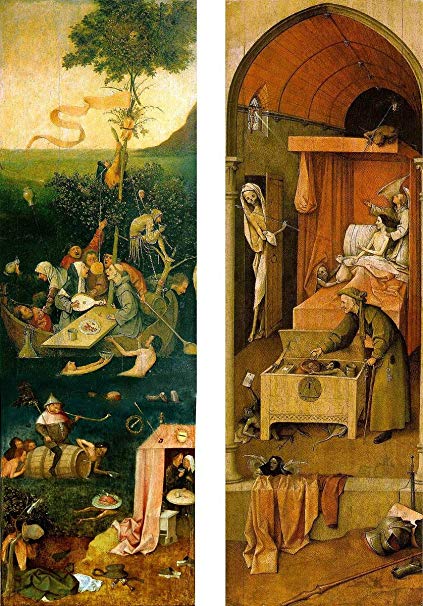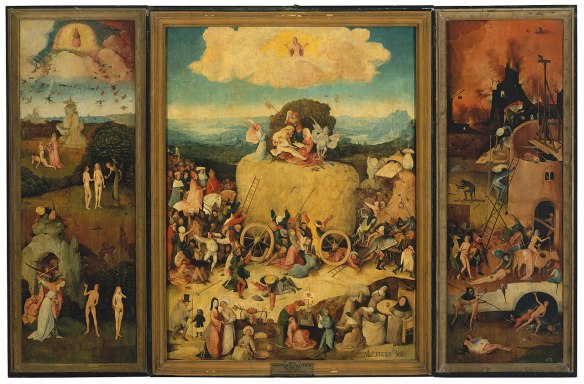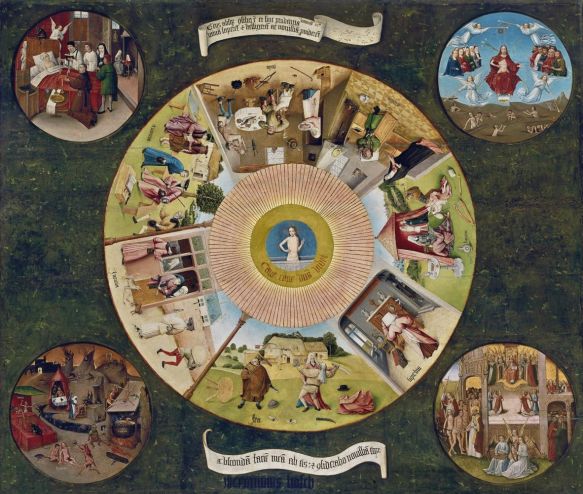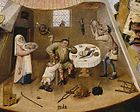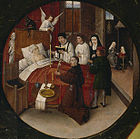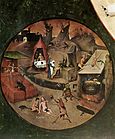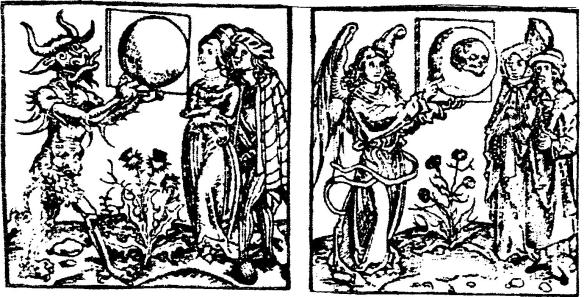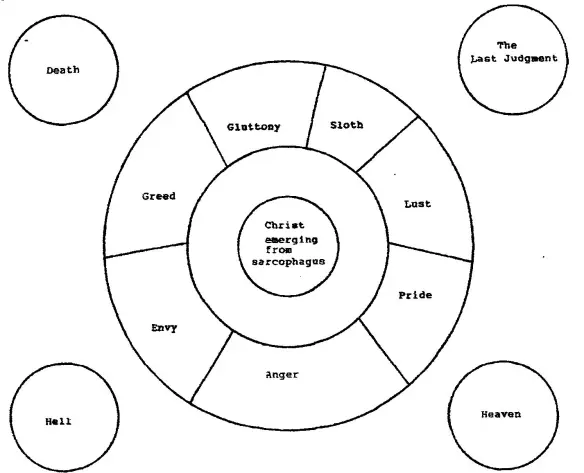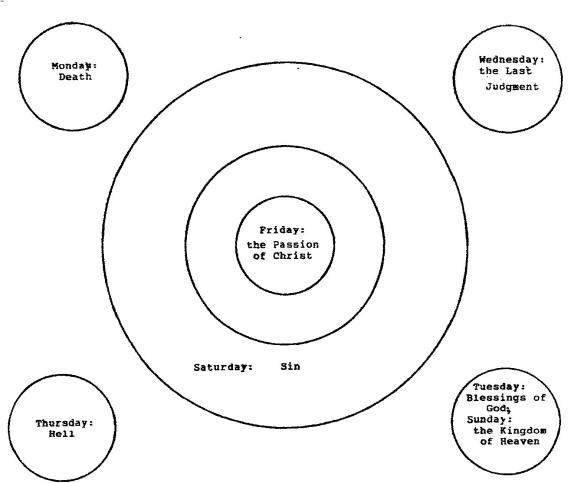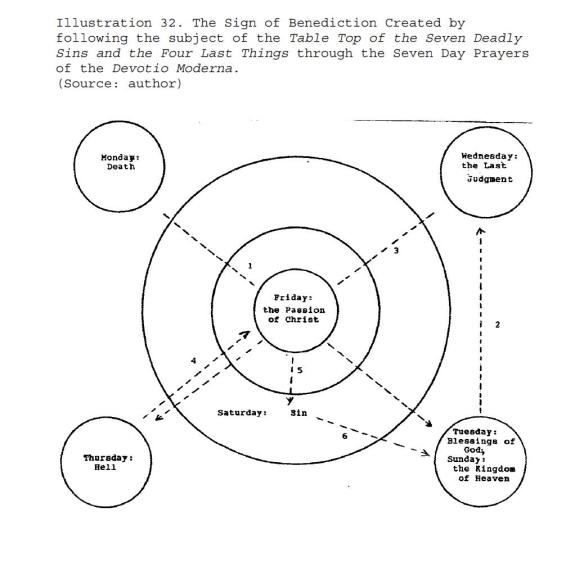- A lifelong pilgrimage: The Mirror of Jheronimus bosch
 Bosch makes art personal, on different levels, and thatmakes him modern. He was one of the first artists in the Low Countries to sign his paintings: ‘Jheronimus bosch’. It was plainly important to him that the works he left behind should be traceable to him. The Haywain (cat. 5) too was signed with his standard signature, affixed like a stamp to the bottom right of the central panel. Bosch also made his art personal, however, for those who look at it. The Haywain is so famous nowadays that it is hard to imagine that when he created it no other painting existed with this subject matter or anything remotely resembling it. We do not know of a single visual precursor for either the Haywain or the Wayfarer. Bosch created an image here that is entirely contemporary – hypermodern art from around 1510–15. Despite their moralizing content, the Haywain and the Wayfarer are not dogmatic paintings; they hold up a mirror to their viewers, to teach them to see themselves better. It was important to Bosch to make his viewers aware of how they bumble their way through life, longing for earthly things. He offered them a personal, exploratory way to realize that if they were to avoid hell and damnation they needed to turn to the good. It is also an important shift in emphasis in the approach to the question of what it means to be a good Christian. Bosch’s work is closely related in this respect to the message of the Devotio Moderna. ( Brethren of the Common Life)
Bosch makes art personal, on different levels, and thatmakes him modern. He was one of the first artists in the Low Countries to sign his paintings: ‘Jheronimus bosch’. It was plainly important to him that the works he left behind should be traceable to him. The Haywain (cat. 5) too was signed with his standard signature, affixed like a stamp to the bottom right of the central panel. Bosch also made his art personal, however, for those who look at it. The Haywain is so famous nowadays that it is hard to imagine that when he created it no other painting existed with this subject matter or anything remotely resembling it. We do not know of a single visual precursor for either the Haywain or the Wayfarer. Bosch created an image here that is entirely contemporary – hypermodern art from around 1510–15. Despite their moralizing content, the Haywain and the Wayfarer are not dogmatic paintings; they hold up a mirror to their viewers, to teach them to see themselves better. It was important to Bosch to make his viewers aware of how they bumble their way through life, longing for earthly things. He offered them a personal, exploratory way to realize that if they were to avoid hell and damnation they needed to turn to the good. It is also an important shift in emphasis in the approach to the question of what it means to be a good Christian. Bosch’s work is closely related in this respect to the message of the Devotio Moderna. ( Brethren of the Common Life)
According to this spiritual movement, which was particularly strong at the time in the Low Countries, human beings themselves are responsible for their actions: they have to reflect and to make choices, and will be held to account for them personally. ‘Modern Devotion’ also believed that everyone should read the Bible in their own language so they could truly understand the Christian message. Bosch painted in such a way that his paintings likewise have to be ‘read’. We are invited to look, reflect, relate the image to ourselves, and to take its moral to heart. Alongside the familiar positive examples, Bosch introduced exempla contraria – ones to be avoided. In these cases, turning to the good was a question of turning away from evil: a long and arduous road, and a lifelong pilgrimage.
The Mysteries of Hieronymus Bosch:
Interpretations of Bosch’s paintings have been varied and extreme: heresy, alchemy, drugs, witchcraft and, the most popular, that he was a member of a secret sect which practised orgies.
Nicholas Baum , who has been fascinated by these haunting paintings for many years, began his investigation in the belief that we would never know their full meaning. After a journey which took him to Holland, Spain. and Portugal, he is convinced that he has found the key. Documentary 1980
Paintings: The Garden of Earthly Delights, The Last Judgment, The Adoration of Maggi, The Haywain Triptych, Cutting the stone, The Temptation of St Anthony
A lone traveller has come from somewhere and plods his way somewhere else in a scene that contains all sorts of elusive elements. Hieronymus Bosch did not create this as an autonomous painting: the round image was originally located on two wings which, when closed, formed a vertical, rectangular surface. The join divided the scene in two, running straight through the traveller and the precise point where the wickerwork pack on his back is fastened shut. The interior of the two wings featured the Ship of Fools on the left and Death and the Miser on the right.
The subject of the now lost central panel is not known. Death is the lone figure’s ultimate destination, as he travels onwards without knowing his future. The road ahead is closed by a gate, while an aggressive dog growls at his heels. The traveller has just passed a house of ill repute, and the landscape in the distance looks barren and desolate. The man’s identity has been left deliberately vague: we cannot see what he has in his pack.
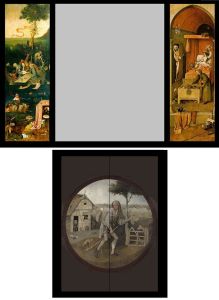 There is nothing to specify that he is a pedlar (as the painting is frequently titled), nor does he wear a pilgrim’s badge. With what few possessions he has, he trudges cautiously, perhaps even hesitantly, through life, looking back over his shoulder and moving ever forwards. Like all of us, he can do nothing else. He is ‘Everyman’ – the literary figure in whom everyone should recognize themselves. The tondo is like a mirror on a wall; the viewer sees life’s pilgrim on his road and like him must choose which course to take without deviating from the true path. Will the traveller open the gate and continue on his way, despite the ox who blocks his path? Or will he wander off into sin and vice? He will ultimately be held to account for the choices he has made, for how he has led his life. Whatever the precise subject of the triptych’s central panel, the message must have been the one Bosch depicts here.
There is nothing to specify that he is a pedlar (as the painting is frequently titled), nor does he wear a pilgrim’s badge. With what few possessions he has, he trudges cautiously, perhaps even hesitantly, through life, looking back over his shoulder and moving ever forwards. Like all of us, he can do nothing else. He is ‘Everyman’ – the literary figure in whom everyone should recognize themselves. The tondo is like a mirror on a wall; the viewer sees life’s pilgrim on his road and like him must choose which course to take without deviating from the true path. Will the traveller open the gate and continue on his way, despite the ox who blocks his path? Or will he wander off into sin and vice? He will ultimately be held to account for the choices he has made, for how he has led his life. Whatever the precise subject of the triptych’s central panel, the message must have been the one Bosch depicts here.
The pig’s trough on the left behind the traveller will immediately have reminded Bosch’s contemporaries of the Parable of the Prodigal Son. Christ told the story of a man who was such a wastrel that he ended up having to tend pigs and envying them their swill. He eventually returned to his father, full of remorse, and was received with great rejoicing (Luke 15:11–32). Yet that is not the story depicted here, either.
The scene Bosch has painted is at once realistic and elusive; it makes the viewer think. All sorts of details contribute to this effect: why is the man wearing a pig’s trotter as an amulet and why is there a cat skin hanging from the spoon on the outside of his pack? Why is there an awl with a loop of thick yarn stuck in the hat he clutches while wearing a chaperon on his head?
There are all sorts of dubious goings-on at the tavern he has just passed: the inverted jug that sticks up from the apex of the gable, the underwear hanging from the window, the little swan on the inn sign, the man urinating round the corner, and the couple canoodling in the doorway are all ominous signs.
An owl high up in the tree has its eye on a titmouse perched a few branches lower, in a visual echo of our own observation of the painting. It is not clear whether the kneeling ox is aware of the magpie at the bottom of the closed gate in front of him, but he probably is. This is all about watching and being watched; human beings too are constantly observed on their life’s path.
The same idea is expressed more explicitly and with detailed commentary in a contemporary German woodcut, in which the principal character is likewise a traveller. While the devil seeks to waylay him, the human being has to travel onwards as a pilgrim until death tears him away from life. He is surrounded by angels offering good advice, while God – shown high in the middle as the Holy Trinity – looks on and will judge. The image as a whole is presented as a mirror, as emphasized by the title and the text in the banderole: ‘Look, see your reflection and take the message to heart.’ Bosch too has painted a mirror showing the hazardous road through life and the choices that humans must make between good and evil.
mirror-of-understanding Spiegel-der-vernunft :
A Christian pilgrim, identified by his hat, staff, and knapsack, is shown in the mirror. He walks the road of life, symbolized by a perilous, roughly hewn bridge with branch stubs to trip him up. The devil pulls him backward, toward worldly pleasures, while at the far end Death, with a bow and a clock, measures his allotted time. Beyond Death there is resurrection and the Last Judgment. Below the bridge is a grave, and below that a Hellmouth, while at the top of the image the Trinity are shown, along with the Virgin and the Fountain of Life. Behind the medallion with the Trinity are ten spheres, the lowest showing the Moon, Sun, and stars while the other nine illustrate choirs of angels. A crucifix links this heavenly scene with the tableaux of the mirror, while four angels give advice. The central image is related to Bosch’s The Path of Life (the exterior image on The Haywain Triptych) and his Wayfarer tondo, as well as Durer’s Knight, Death, and the Devil.
-
- The Ship of Fools
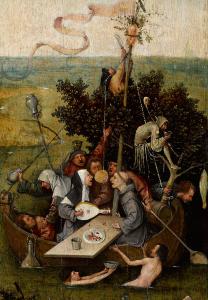 The ship of fools is an allegory, originating from Book VI of Plato’s Republic, about a ship with a dysfunctional crew:
The ship of fools is an allegory, originating from Book VI of Plato’s Republic, about a ship with a dysfunctional crew:
Imagine then a fleet or a ship in which there is a captain who is taller and stronger than any of the crew, but he is a little deaf and has a similar infirmity in sight, and his knowledge of navigation is not much better. The sailors are quarreling with one another about the steering––every one is of the opinion that he has a right to steer, though he has never learned the art of navigation and cannot tell who taught him or when he learned, and will further assert that it cannot be taught, and they are ready to cut in pieces any one who says the contrary. They throng about the captain, begging and praying him to commit the helm to them; and if at any time they do not prevail, but others are preferred to them, they kill the others or throw them overboard, and having first chained up the noble captain’s senses with drink or some narcotic drug, they mutiny and take possession of the ship and make free with the stores; thus, eating and drinking, they proceed on their voyage in such a manner as might be expected of them. Him who is their partisan and cleverly aids them in their plot for getting the ship out of the captain’s hands into their own whether by force or persuasion, they compliment with the name of sailor, pilot, able seaman, and abuse the other sort of man, whom they call a good-for-nothing; but that the true pilot must pay attention to the year and seasons and sky and stars and winds, and whatever else belongs to his art, if he intends to be really qualified for the command of a ship, and that he must and will be the steerer, whether other people like or not––the possibility of this union of authority with the steerer’s art has never seriously entered into their thoughts or been made part of their calling. Now in vessels which are in a state of mutiny and by sailors who are mutineers, how will the true pilot be regarded? Will he not be called by them a prater, a star-gazer, a good-for-nothing
 When the triptych opens, the mirror ‘breaks’ and its contents – or rather the view it offers of them – are shown inside. We will begin with what was once the left wing, with its boatload of merrymakers, surrounded by drunkards and lovers. These are people in the flush of their lives, concerned with neither God nor his commandments. They have given themselves over to eating, drinking, swimming and lovemaking, and their most pressing concern seems to be the pie balanced on the head of one of the swimmers, which they are eager to get onto dry land in one piece. Death still seems a long way away. None of the figures realizes what Sebastian Brant declared in the prologue to his Stultifera Navis ( Ship of Fools , 1497), namely that ‘In the ship, we are separated but three fingers’ breadth from death.’
When the triptych opens, the mirror ‘breaks’ and its contents – or rather the view it offers of them – are shown inside. We will begin with what was once the left wing, with its boatload of merrymakers, surrounded by drunkards and lovers. These are people in the flush of their lives, concerned with neither God nor his commandments. They have given themselves over to eating, drinking, swimming and lovemaking, and their most pressing concern seems to be the pie balanced on the head of one of the swimmers, which they are eager to get onto dry land in one piece. Death still seems a long way away. None of the figures realizes what Sebastian Brant declared in the prologue to his Stultifera Navis ( Ship of Fools , 1497), namely that ‘In the ship, we are separated but three fingers’ breadth from death.’
-
-
- The Triptychs and the Devotio Moderna
-
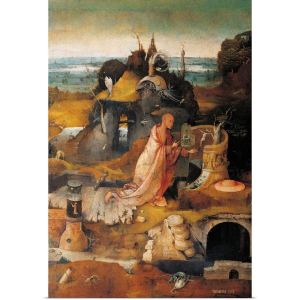 The name saint of Hieronymus Bosch was the great patron saint of the Hieronymians who had been established in ‘s-Hertogenbosch since 1425, but it is not known whether these Brothers of the Common Life and the movement of the Devotio Moderna had a direct relationship with Bosch’s parents or later with Hieronymus himself. The Brother’s House was indeed an intellectual focus within the town, there were scholars, many books and shortly before Bosch died the brothers themselves were printing books and dealing in them. The spirit of the Devotio Moderna was cultivated and propagated in various ways.
The name saint of Hieronymus Bosch was the great patron saint of the Hieronymians who had been established in ‘s-Hertogenbosch since 1425, but it is not known whether these Brothers of the Common Life and the movement of the Devotio Moderna had a direct relationship with Bosch’s parents or later with Hieronymus himself. The Brother’s House was indeed an intellectual focus within the town, there were scholars, many books and shortly before Bosch died the brothers themselves were printing books and dealing in them. The spirit of the Devotio Moderna was cultivated and propagated in various ways.
It is remarkable – coincidence appears to be out of the question – that the majority of Bosch’s surviving triptychs are directly and intensively linked to the message of this religious movement.
Hieronymus Bosch’s three most famous triptychs, The Haywain, The Garden of Earthly Delights (Madrid, Prado and Escorial) and The Last Judgement (Vienna), and also Christ Carrying the CrossfVienna) and the Wayfarer (Rotterdam) – it once adorned the wings of a triptych – transcend the traditional iconography of the triptych. It seems that these triptychs were largely determined by the thoughts and religious message of the Devotio Moderna.
The Haywain The Garden of Earthly Delights
The Last Judgement Christ Carrying the Cross
This reformatory movement called on every believer to give his or her own interpretation to Christianity, in a personal perception and individual following of Christ. Every person should follow Christ and the saints as examples and they each should interpret the nature of a good Christian life. Each individual must himself or herself, and in full consciousness of their sinftilness, continually choose between good and evil. Only through intense awareness of human iniquity was it possible, and at the same time necessary, to strive for salvation.
The figure of the wayfarer – both on the outside panels of the two versions of the Haywain Triptych (Prado and Escorial) and the now octagonal panel in Rotterdam – shows an image of allegorical texts in which the whole of human existence is conceived as a pilgrimage. This stems from a powerful Middle Ages tradition that can be seen, for example, in the Middle Netherlands publication entitled Boeck van den pelgherym (Book of the Pilgrim),by Jacob Bellaert which appeared in Haarlem in 1486.
This book explicitly laid down the notion that all people are pilgrims on their way to a heavenly Jerusalem. Bosch, however, did not portray his wayfarer as a stereotypical pilgrim, with all the well-known attributes that would characterize him as such.
The negative associations which people of Bosch’s time had of wandering pilgrims, whether or not they were on their way to a specific place of pilgrimage, could not be associated with this ‘pilgrim of life’.
 Indeed, Bosch did refer to plodding, and thus to the idea of humanity making a pilgrimage. Every person as a devoted believer must find his or her own way with God’s help. For this purpose the traveller is equipped with a number ofpractical attributes, such as a strong staff, which is at the same time symbolic. The painter did not portray this staff as the typical long pilgrim’s staff, but as club-like stick with which the marching traveller wards off the threatening dog.
Indeed, Bosch did refer to plodding, and thus to the idea of humanity making a pilgrimage. Every person as a devoted believer must find his or her own way with God’s help. For this purpose the traveller is equipped with a number ofpractical attributes, such as a strong staff, which is at the same time symbolic. The painter did not portray this staff as the typical long pilgrim’s staff, but as club-like stick with which the marching traveller wards off the threatening dog.
Bosch seems literally to have painted a passage from the Middle Netherlands adaptation of the Speculum Humanae Salvationis (The mirror of human salvation): in many places the pilgrim must journey along back roads and needs a stick to ward off threatening dogs. The staff symbolizes the belief that humanity offers a footing not to stray from the righteous way, and serves him as a weapon.
Bosch’s travelling man has packed his belongings in the big basket on his back and carries this earthly burden along the path of life. He must lead his life in imitation of Christ; he must bear His burdens, contemplating His example from hour to hour and from day to day. Bosch’s interpretation of the toiling wayfarer is established by the title page of an early printed edition of Thomas van Kempen’s famous book De Navolging van Christus (The Imitation of Christ), Antwerp 1505.
The frontispiece is a woodcut with the representation of Christ, as Salvator Mundi, offering a blessing. To the side of the illustration, in both Latin and Middle Dutch, is a sentence from the New Testament: “Whoever follows me will never walk in darkness, but will have the light of life” (John 8:12). These opening words of The Imitation are typical of the whole movement of Devotio Moderna. On the title page Christ offering a blessing is looking sideways at a man in the margin of the page, trudging along among tendrils and monsters. His pack is filled with plucked grapes, in which the Eucharistic symbolism is, of course, evident.
When opened, the three triptychs The Haywain, The Garden of Earthly Delights, and The last Judgement, each show almost an entire representation of the Christian story, from Paradise to Hell.
Each illustrates the great contrast between the heavenly world that inevitably ends in the Fall and eternal punishment of the sinful man, doomed by the last judgement. The cautionary message, which was the essence of the Devotio Moderna, is transmitted over the entire continuous landscape of the outer tableaux and the main tableau between them.
In ‘Paradise’, the left wing of the triptych The Garden of Earthly Delights, only the creation of the first, still innocent couple is portrayed. The animal world was never free of sin and the lion mauling a deer and the cat with a mouse in its mouth emphasise the inevitability of the approaching Fall. The central panel of The Garden of Earthly Delights depicts multi-coloured, voluptuous and innocent mankind. Only God’s creation is portrayed, there is still nothing that has been made by man: a vision of an unashamed, tranquil, paradisiacal society. The Hell wing portrays shows what happens – ruin and punishment – when man makes his contribution. Hell is loaded down with man-made instruments. Just as man is responsible for his sins, so is he the maker of the instruments of torture, for which all things, even perfect musical instruments, are deployed.
The creation of the first couple in the paradise of The Haywain triptych is placed once again on the left wing, although depicted far in the background; in the mid-section of this panel we see the Fall and in the foreground the sinful human couple being driven out of paradise; here the sinful couple is the most important aspect. High up in heaven the Fall and the expulsion from paradise are given an extra emphasis and are foretold by the struggle taking place between good and evil, the fall of the angels. The consequences of being driven out of paradise is illustrated in the central panel, where the continuation of the world is shown far beneath the relatively small risen Christ in the clouds above: the sinful course of human existence, the journey of the haywain, followed by people of all ranks and classes, which is travelling in the direction of Hell, of course, the threatened destination for sinful mankind.
The ‘s-Hertogenbosch archivistjan Mosmans, cited earlier in this book, dated The Haywain as being painted in 1494 on the grounds of an extremely precise interpretation of the various dignitaries at the back of the procession. This meticulous identification is not tenable and today has also become unacceptable; dendrochronological dating of both versions of the Haywain exclude such an early dating (Escorial, c. 1504 or later; Prado, 1515 or later) – although an earlier prototype is not impossible. What is clear is that in elements of the procession, in the assemblage of the common folk together with the elite, Bosch was inspired by the parades and processions in the town, such as those that took place at the Joyful Entrances of the Burgundian dukes during religious celebrations.
The Last Judgement triptych is again ordered in the same way: on the left paradise, in the centre the main tableau, on the right hell. The creation of the first human couple in an earthly paradise is again placed wholly in the foreground, while the Fall takes place in the centre and the expulsion from paradise is pushed into the background. High above all this the fall of the rebellious angels takes place under the watchful eye of the Creator. The archangel Michael and his host of angels drive Lucifer and his followers into the depths and later the same archangel drives Adam and Eve out of paradise. The sinful descendents of the first couple largely compose the picture on the central panel, where the Last Judgement takes place. The earth is completely populated by sinners who are being overwhelmed by devils and monsters; in the distance the land burns and on the left hand of Christ as Judge the sky is black. Darkness and all-consuming fire run through to the tableau of hell where the damned remain for all eternity.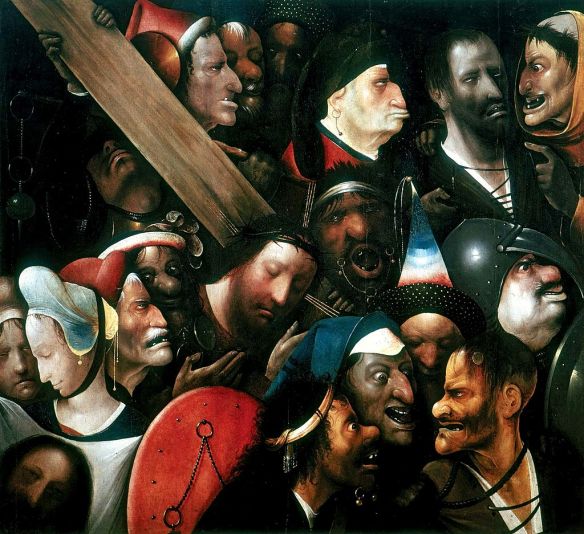
The panel of Christ Carrying the Cross in Vienna is the left wing of a triptych that would have had the Crucifixion as its main subject, or possibly a Calvary, a depiction of the Redeemer who had died on the cross. A child at play is painted on the reverse (outside) of this panel. A child would also have been painted on the outside of the right wing of this triptych.
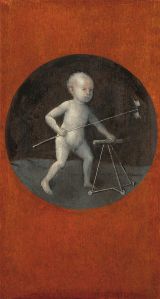 These children could be interpreted as the young Christ and John; various parallel representations have survived in which a cross halo for the Christ child and an ordinary halo for John make such an identification possible. In paintings by Hieronymus Bosch neither person has a halo, thus every believer could identify with the child.
These children could be interpreted as the young Christ and John; various parallel representations have survived in which a cross halo for the Christ child and an ordinary halo for John make such an identification possible. In paintings by Hieronymus Bosch neither person has a halo, thus every believer could identify with the child.
The little windmill and the unsteady walking frame he holds on to appear to indicate the relativity and vulnerability of human existence. The child, the human being, must lead his life in the footsteps of Christ. The child is doing this very literally; windmill in hand he steps out carefully, exactly as the suffering Christ with the wooden cross on the other side of the panel.
On the outside of The Haywain, the triptych which most powerfully shows the sinful course of the history of mankind in all ranks and classes, stands this man, the ‘pilgrim of life’. Similar figures are also shown on the reverse sides of the panels of The Last Judgement in Vienna.
 On the left wing St James the Greater is portrayed as a pilgrim and apostle. Here life’s pilgrimage is further elaborated in two small scenes in the background. First, there is a blind man leading another blind man, which represents wandering man who is helpless and, stumbling, must advance in ignorance. Further along a traveller is being robbed – it is a dangerous road. St Bavo, on the other wing, is giving aims to the poor and as such also has an exemplary function.
On the left wing St James the Greater is portrayed as a pilgrim and apostle. Here life’s pilgrimage is further elaborated in two small scenes in the background. First, there is a blind man leading another blind man, which represents wandering man who is helpless and, stumbling, must advance in ignorance. Further along a traveller is being robbed – it is a dangerous road. St Bavo, on the other wing, is giving aims to the poor and as such also has an exemplary function.
Undoubtedly Bavo is also an indication of the original destination or commissioner. The repeated suggestion that this is The Last Judgement triptych that Philip the Handsome made a down payment for in 1504, however, is not tenable. The sophisticated argument that St Bavo was placed here as the representative saint of the Netherlands, opposite James as the patron saint of Spain, is not valid because Bavo never obtained a comparable position and even as a saint was very seldom venerated.
 On the reverse of The Garden of Earthly Delights, finally, stands the first beginning; the desolate world that must still be completed.
On the reverse of The Garden of Earthly Delights, finally, stands the first beginning; the desolate world that must still be completed.
God the Father as creator is almost ready to set down the animals and, as completion, mankind, after which it will fail because of man’s imperfection.
The outer panels are generally thought to depict the creation of the world, showing greenery beginning to clothe the still-pristine Earth. God, wearing a crown similar to a papal tiara (a common convention in Netherlandish painting),is visible as a tiny figure at the upper left. Bosch shows God as the father sitting with a Bible on his lap, creating the Earth in a passive manner by divine fiat. Above him is inscribed a quote from Psalm 33 reading: “Ipse dixit, et facta sunt: ipse mandāvit, et creāta sunt“—For he spake and it was done; he commanded, and it stood fast . The Earth is encapsulated in a transparent sphere recalling the traditional depiction of the created world as a crystal sphere held by God or Christ. It hangs suspended in the cosmos, which is shown as an impermeable darkness, whose only other inhabitant is God himself.
Note: The same is to be seen in the Quran with his ” Kun fa-yakūnu” :
Kun (كن) is an Arabic word for the act of “manifesting“, “existing” or “being“. In the Qur’an, Allah commands the universe to “be” (“kun!” كن!), so that it is (fa-yakūnu فيكون).
Kun fa-yakūnu has its reference in the Quran cited as a symbol or sign of God’s mystical creative power. The verse is from the Quranic chapter, Surah Ya-Sin. The context in which the words kun fa-yakūnu appear in the 36th Chapter, verse number 82:
Does man not consider that We created him from a [mere] sperm-drop – then at once he is an open disputant? And he presents an (argument of) likeness for Us and forgets his own creation. He asks (in confusion): “Who will give life to the bones when they are disintegrated?” Say: “He will give life to them Who brought them into existence at first, and He is cognizant of all creation.” He Who has made for you, from the green tree, fire. and then from it you kindle (fire). Is not He Who created the heavens and the earth able to create the like of them? Yes Indeed! and He is the Superb Creator (of all), the Ever-Knowing. Surely His Command, when He wills a thing, is only to say to it: Be! and it is!” Therefore glory be to Him in Whose hand is the Kingdom of all things, and to Him you shall be brought back.
The term also appears as part of 117th verse of the 2nd Quranic chapter, Surah Baqara.
(Allah,) The Originator of the heavens and the earth. When He decrees a matter, He only says to it, “be”, and it is.
There are eight Quranic references to kun fa-yakūnu:
- “She said: “O my Lord! How shall I have a son when no man hath touched me?” He said: “Even so: Allah createth what He willeth: When He hath decreed a plan, He but saith to it, ‘Be’, and it is!””[3:47]
- “The similitude of Jesus before Allah is as that of Adam; He created him from dust, then said to him: “Be”. And he was.”[3:59]
- “It is not befitting to (the majesty of) Allah that He should beget a son. Glory be to Him! when He determines a matter, He only says to it, “Be”, and it is.”[19:35]
- “To Him is due the primal origin of the heavens and the earth: When He decreeth a matter, He saith to it: “Be”, and it is.”[2:116–117]
- “It is He who created the heavens and the earth in true (proportions): the day He saith, “Be”, behold! it is. His word is the truth. His will be the dominion the day the trumpet will be blown. He knoweth the unseen as well as that which is open. For He is the Wise, well acquainted (with all things).”[6:73]
- “Verily, when He intends a thing, His Command is, “be”, and it is!”[36:82]
- “For to anything which We have willed, We but say the word, “Be”, and it is.”[16:40]
- “It is He Who gives Life and Death; and when He decides upon an affair, He says to it, “Be”, and it is.”[40:68]
- Triptychs Bosch and the ideas of the Devotio Moderna.
On these triptychs Bosch does depict the traditional account of the Creation and Fall – not, however, in the usual manner, but with a very unusual slant and greatly inspired by the ideas of the Devotio Moderna. The main subject is not Christ’s work of Redemption, or the positive example of a holy martyr or confessor, nor help for humanity from intercessors. The central theme in these works by Bosch is the road the soul of the individual believer must travel. The Garden of Earthly Delights, The Haywain and The Last Judgement lead almost exclusively to Hell.
Without any positive prospect the viewer is confronted with his own sinfulness and is thus completely thrown back on himself.
The subject is always the creation of mankind and what mankind makes of it;
then what is waiting for him if he persists in what is ‘typical’ of him, namely sinful behaviour, such as that which was already contained in the paradisiacal beginning.
God created man and God sees how things go wrong; everything takes place under God’s eye. The Christ figure high above the haywain shows by the wound in his side and the wounds of the cross in his hands and feet that salvation is always possible for those who follow Him. The small Christ figure is therefore very important.
 Paradoxically he must be as small as possible and partly hidden in the clouds. Indeed, the larger Christ is depicted, the shorter the road that the believing soul must travel is suggested.
Paradoxically he must be as small as possible and partly hidden in the clouds. Indeed, the larger Christ is depicted, the shorter the road that the believing soul must travel is suggested.
The WayFarer, The Ship of Fools and Death of the Miser The WayFarer in Rotterdam strongly resembles the figure pulling the wagon in The Haywain triptych.
Furthermore, examination proved that this painting once was a companion piece together with three other panels. At some unknown point in time two triptych panels with The WayFarer painted on the outer side were split and sawn up. The Ship of Fools, which is in the Louvre. and the Man on the Barrel, which is in New Haven in the United States, formed the inner side of the left wing and The Death of the Miser, which is in New York, was the reverse side of the right wing. Nothing is known of the vanished central panel, but it is certain that the main subject would have been in a programmatic relationship to the wings. In comparison to The Haywain here there would appear to be a question of a reverse programme: here human imperfections – wickedness, unbelief and incomprehension, foolishness – are portrayed on the inner sides of the wings. A reference to the End of Time – a Last Judgement scene or an apocalyptic vision – on the central panel would have led to a similar thematic whole. In foolishness (The Ship qfFools) and transgression (Death of the Miser) every human being sets course to their individual end, and humanity in general to the End of Time (central panel), when the course of every individual’s life will be judged (closed wings).
- Saint John on Patmos
A small wooden panel “Saint John on Patmos” one of the few works of Hieronymus Bosch, equipped with author’s signature.
“Saint John on Patmos” (1504-1505) belongs to the late, so-called “austere” period of Bosch, when, after the satirical early works and the Mature period, with its almost sinful delight “the garden of earthly delights” the artist from the image of demonic temptation turns to the theme of Holiness.
St John the Evangelist :
Among all the apostles the name of St. John is used in the Bible text most often. The son of the fisherman Zebedee, he was called by Christ one of the first together with his brother Jacob. Jesus called them “sons of thunder” – probably for the impetuosity and vehemence. The authorship of John the Evangelist is attributed to not only the eponymous gospel (4th in a row), but also conciliar Epistles and the Apocalypse is the most mysterious and the most frightening of the books of the New Testament, announcing the end of the world.
After the death and resurrection in 33 ad John preached a long time in neighboring countries, had been subjected to hazards coming into conflict with the pagans, and the Roman emperors Nero and Domitian. Apocryphal texts tell us that John was able to resurrect the dead, but he managed to escape death, even when immersed in a cauldron of boiling water. In the 60 years of the first century ad, the Emperor Domitian banished John to the Isle of Patmos. There John continued to convert the pagans, and then withdrew to a deserted mountain, where, after three days of fasting and continuous prayer through it was to hang the Spirit of God, prophesying about the last days of the world. Recorded prophecies made the Book of Apocalypse (Revelation of John the theologian). Apparently, it keeps the character of Bosch in the knees.
Interestingly, at the time of the writing of the Apocalypse of John, by all accounts, should have been already very old man, but Bosch shows him in keeping with this tradition is quite young. This young, somewhat naive appearance, curly hair, pink vestments to symbolize the inner purity of John.
Angel:
Winged angel on the hill encourages John to record the visions coming to him. It is made with a certain grace and completely in blue tones – I think that in this way Bosch emphasizes its immaterial, immateriality. However, it is alarming that similar, with pointed wings and a ghostly blue glow in other works of Hieronymus Bosch depicted demons (for example, in the triptych “The hay”).
Virgo:
In the upper left corner, where aspiring view John Bosch depicts a female silhouette. This is the image of the Apocalypse – “the woman clothed with the sun, under her feet the moon, and on her head a crown of twelve stars”. Most often, the image of the wife of Apokalipsa is seen as a symbol of the Christian Church in times of persecution, and from about XII century some theologians began to identify the wife of Revelation with the Virgin Mary. The Bosch she is holding a baby – apparently, this means that Bosch is well familiar with this kind of theological subtleties, takes this analogy.
Eagle:
Why at the feet of John Bosch depicts eagle? The eagle, the traditional iconographic symbol of St. John the Evangelist. In the medieval treatise “Sermons on the Gospels” (1489) contains this description of John: “In comparison with the other evangelists he is like the eagle. As the eagle flies higher than all birds, as he is above all creatures that can look at the sun without damaging our eyes, and Saint John the Evangelist perceived the light of the Lord subtly and clearly, and thus have seen more than this to anyone living before and after him.”
Eagle Bosch exists on the same line as demon. Their views crossed. Between them there is a silent confrontation, such a confrontation between good and evil.
Daemon:
There is a misconception that a demon attempting to steal the theologian ink – a product not so much of the Bible as purely Bolhovskoy demonology. And really, who, in addition to Bosch, could be the mutant, the demon, bespectacled man with a head the sad man and the body of the insect, its chitinous shell, jointed legs and scorpionic tail? But actually this is a direct illustration of the text of the Apocalypse, where it is said “Out of the smoke onto the earth came locusts, she was given the same authority that was given on the ground Scorpios (…) the Locusts looked like war horses, kitted out in battle… their faces were as the faces of men…” (Rev. 9:3-7).
The flip side:
On the back there is another picture made in the technique of grisaille (FR. grisaille – single color image, usually in grey or brown tones). It is considered the face. This confirms the conjecture that the “Saint John on Patmos” – not a separate product, and the fold of the lost triptych. Judging by the direction of gaze of John, the fold was right.
Back image is a double circle, symbolizing the “all seeing eye” or “eye of salvation” (structurally, it is like a circle of “Seven deadly sins”). At the perimeter of the outer circle are the passion of Christ – scenes of the earthly life of Christ; and in the center, in the so-called “pupil” shows the high rock sitting on her bird. A number of associations here, at least, double. First, the rock legitimately identified with the mountain where John was shown the Revelation, and then the bird is, of course, eagle. Second, no less popular version that is depicted here is not the eagle and the Pelican, which, according to legend, feeds nestlings with his own blood, it is logical to associate with the blood of Christ made for all the sons of God, and then depicted Bosch mount – Calvary.
- Observations on the symbolism of the “pupil” from a painting by Hieronymus Bosch
 In a round “eyepiece” by Hieronymus Bosch entitled “Stories of the Passion” , in the center, in the “pupil”, is depicted the Pelican that feeds its young with its own blood, while in the “iris” it is found represented the story of the Passion and Crucifixion of the Messiah on Mount Golgotha.
In a round “eyepiece” by Hieronymus Bosch entitled “Stories of the Passion” , in the center, in the “pupil”, is depicted the Pelican that feeds its young with its own blood, while in the “iris” it is found represented the story of the Passion and Crucifixion of the Messiah on Mount Golgotha.
With regard to this special symbolic correlation between the “Source of Life” (here, by analogy, represented respectively by the wounded chest of the Pelican and by the pierced side of Christ, from which both the living Blood flows), and the “Eye “Divine (Who sees everything in a single timeless present) – let us also observe that also in the Arabic language the word ‘ayn, besides denoting a” source “(‘ ayna d-hayye is the” Fountain of Life “, second the Syrian author Jacopo di Sarūg), also means “eye”.
For Ibn ‘Arabî, in Islamic esotericism, in fact the term’ ayn has a close relationship with the very notion of “universal Man”, for example we read in the part dedicated to the Word of Adam in Kitāb Fusūs al-Hikam I, 2: “Man [insân] is to God what the pupil [insân al-‘ayn, lett. “The man in the eye” is for the eye, since the pupil is the instrument of the gaze “, and again,” […] God contemplates creatures [through the Universal Man and “pupil” of His Look] and give them mercy [inasmuch as He is ar-Rahmân “.
 Even in the Norse Nordic tradition, traces of this symbolism can be found in the well-known episode of the sacrifice of the eye by Odin to the “source of wisdom” [Mímisbrunnr, “the source of Mímir” or “source of memory”; yes see the Greek mimnesco = “memory”] guarded by the wise giant Mímir, on whose “skull” the god Odin relies to know the future.
Even in the Norse Nordic tradition, traces of this symbolism can be found in the well-known episode of the sacrifice of the eye by Odin to the “source of wisdom” [Mímisbrunnr, “the source of Mímir” or “source of memory”; yes see the Greek mimnesco = “memory”] guarded by the wise giant Mímir, on whose “skull” the god Odin relies to know the future.
We have read, again in this regard, a very interesting article which we also report here: by Paolo Magnone, “The master, the pupil and the pupil between India and Greece” in I Quaderni di Avallon, Rimini, 48 (2000), pp.45-58 . The author makes use of several traditional quotations to demonstrate the traditional importance of the cognitive transition between master and student, an intellectual activity that was considered “sacred” by the ancients, and in particular focuses on the etymological value of the word “ pupil »from the Latin pūpa o pūpilla =« little girl »« bambolina ». Indeed, as in the Greek language («kórē»), likewise in the Sanskrit language («kanīnaka» or «kanīnikā»), the «pupil» originally indicated «the figurine reflected in the pupillary disc», that is to say the «little girl» or small image of the beholder who sees himself mirrored in the eye of those in front of us.
For example, the Hindu sacred texts affirm that this “little man” reflected in the eye is – by analogy and in a symbolic sense – the true subject of vision and knowledge, the “Purusha in the eye”, the “Self” (Atmâ), the only Real that cannot be known analytically and distinctly from human reason alone, but which, as “One Knower” (evamvid), can only be inferred, that is, taken directly for synthesis through intellectual intuition in metaphysical realization. «With what can [in fact] be known What with which all this is known? This ātman (the Self) is – which is not so, – which is not so (“neti, neti“) “(Brhadāranyaka Upanishad 4.5.15)
The author then goes on to analyze the traditional ancient Greek sources, which in regard to the famous Delphic injunction which reads: “gnôthi seautón” (“know thyself”), differ almost in nothing from the Indian ones on this symbolism of the eye, when, for example, we read in Plato: “[Socrates:] You noticed that when we stare into our eyes, our figure (prósōpon) appears in the eye that is in front of us as in a mirror, and we call it” pupil “(Kórē, that is” maiden “) because it is like an image of the beholder? … So an eye that looks at [another] eye, and hangs in what [it] has better, with which it sees [i.e. the “pupil”, center and light of the eyes], in this way he would see himself [ie, by analogy, his own inner “spiritual self”], and again, “Therefore the eye, if it wants to see itself , must look at the eye, and that point of the eye in which the visual virtue is inherent … and so too the soul, if it wants to know itself, must look at the soul, and especially that point of the soul in which is inherent in the virtue of the soul: wisdom (sophía) “(Alcibiades 132e-133a and 133b).
Although in the article by Paolo Magnone there is no explicit mention of Islamic comparisons, it is clearly evident that these same theories concerning the «Purusha (or Universal Man) in the eye», as expressed here by the Indian and Greek traditions, have very close ties symbolic with the corresponding Sufi doctrine on the human “pupil”, called precisely in the Arabic language insân al-‘ayn (lit. “the man in the eye”), as seen in the previous quoted passage of Ibn ‘Arabî from Kitāb Fusūs al-Hikam.
see also THE ISLAMIC CONCEPT OF HUMAN PERFECTION*
Finally, to return to our “ocular” round by H. Bosch in whose “pupil” the Pelican is depicted, which seems to be the true “inner” meaning of the entire historical cycle of the Passion of Christ , even in the This medieval esoteric doctrine of the “Divine gaze” placed on the Universal Man, in such a way that “… God contemplates creatures [through the Universal Man and His” pupil “] and dispenses their mercy … “, at least it certainly was not in Eastern Christianity, judging also by these remarkable words of Macarius of Mount Athos:” … Look at the men in the pupils. Not the eyes, just the pupils. If you look closely, you find the soul in the pupil”.
 And if you look at the soul, you meet the Presence, the same Presence in all [that is, the “insân al-‘ayn” of Islamic esotericism, the “Purusha in the eye” of the Hindu tradition, and “He who moves everything. .. »in Dante Divina Comedia Paradiso 33, you really feel it and the frenzy ends. The frenzy ends and the fraternity begins “, where we add, the” end of the frenzy “and the” fraternity “are here the exact religious and moral correspondence of the metaphysical” resolution of the oppositions “and” Great Peace “in the” Invariable Mezzo “and” Centro del Mondo “.
And if you look at the soul, you meet the Presence, the same Presence in all [that is, the “insân al-‘ayn” of Islamic esotericism, the “Purusha in the eye” of the Hindu tradition, and “He who moves everything. .. »in Dante Divina Comedia Paradiso 33, you really feel it and the frenzy ends. The frenzy ends and the fraternity begins “, where we add, the” end of the frenzy “and the” fraternity “are here the exact religious and moral correspondence of the metaphysical” resolution of the oppositions “and” Great Peace “in the” Invariable Mezzo “and” Centro del Mondo “.
For More Info about the Devotio Moderna read here
- This pane symbolizing the “all seeing eye” or “eye of salvation” structurally, it is like a circle of “Seven deadly sins
Four small circles, detailing the four last things — Death, Judgment, Heaven, and Hell — surround a larger circle in which the seven deadly sins are depicted: wrath at the bottom, then (proceeding clockwise) envy, greed, gluttony, sloth, extravagance (later replaced with lust), and pride, using scenes from life rather than allegorical representations of the sins.[4]
At the centre of the large circle, which is said to represent the eye of God, is a “pupil” in which Christ can be seen emerging from his tomb. Below this image is the Latin inscription Cave cave d[omi]n[u]s videt (“Beware, Beware, The Lord Sees”).
Above and below the central image are inscription in Latin of Deuteronomy 32:28–29, containing the lines “For they are a nation void of counsel, neither is there any understanding in them”, above, and “O that they were wise, that they understood this, that they would consider their latter end!” below.
Each panel in the outer circle depicts a different sin. Clockwise from top (Latin names in brackets):
- Gluttony (gula): A drunkard swigs from a bottle while a fat man eats greedily, not heeding the plea of his equally obese young son.
- Sloth (acedia): A lazy man dozes in front of the fireplace while Faith appears to him in a dream, in the guise of a nun, to remind him to say his prayers.
- Lust (luxuria): Two couples enjoy a picnic in a pink tent, with two clowns (right) to entertain them.
- Pride (superbia): With her back to the viewer, a woman looks at her reflection in a mirror held up by a demon.
- Wrath (ira): A woman attempts to break up a fight between two drunken peasants.
- Envy (invidia): A couple standing in their doorway cast envious looks at a rich man with a hawk on his wrist and a servant to carry his heavy load for him, while their daughter flirts with a man standing outside her window, with her eye on the well-filled purse at his waist. The dogs illustrate the Flemish saying, “Two dogs and only one bone, no agreement”.
- Greed (avaricia): A crooked judge pretends to listen sympathetically to the case presented by one party to a lawsuit, while slyly accepting a bribe from the other party.
The four small circles also have details. In Death of the Sinner, death is shown at the doorstep along with an angel and a demon while the priest says the sinner’s last rites, In Glory, the saved are entering Heaven, with Jesus and the saints, at the gate of Heaven an Angel prevents a demon from ensnaring a woman. Saint Peter is shown as the gatekeeper. In Judgment, Christ is shown in glory while angels awake the dead, while in the Hell demons torment sinners according to their sins.
Seven Deadly Sins
-



-
Greed (Avaricia)
Four Last Things
-
“Hell” and the punishment of the seven deadly sins.
-
“Glory” or Heaven
- THE SEVEN DEADLY SINS AND THE FOUR LAST THINGS THROUGH THE SEVEN DAY PRAYERS OF THE DEVOTIO MODERNA
Christ’s gaze in Bosch’s painting draws the viewer’s attention. When a member of the Devotio Moderna looked at the painting during his daily prayers, he underwent serious
self-examination which was possible because “visual images” served as a still more effective vehicle for compassionate meditation.
Devils and the Angel’s Mirrors.
Without the gaze of Christ, the painting would not have as great an impact on its viewer in a time of meditation. When the viewer meditates upon the seven day prayers of the Devotio Moderna, he/she sees the image of Christ as the Man of Sorrows looking at him or her. Through this interaction with Christ, the viewer examines his own morals and keeps his faith in God. The viewer’s world is not the physical environment where he lives but the one that is reflected in the Eye of God. As the viewer prays upon the seven day prayers, he will be guided to the Kingdom of Heaven where he will be greeted by the angels and face Christ without any shame or guilt upon the death of the redeemer. The righteous person will keep his faith in God as he sees the image of Christ in the Eye of God.
The eye creates an eternal exchange of the interaction between the viewer and Christ As the image reflects the ‘inner perception’ of the viewer, Bosch’s painting reflects the viewer’s own consciousness in choosing between right and wrong as he undergoes the daily meditations of the seven day prayers of the Devotio Moderna.
Note: Hieronymus Bosch, Painter and Draughtsman: Catalogue Raisonné was published in February 2016 and is based on the findings of the Bosch Research and Conservation Project(brcp). The research reports have been published in full in the present book’s companion volume, Hieronymus Bosch, Painter and Draughtsman: Technical Studies, and can also be consulted online at Boschproject.org. Bosch online (web application with documentation on all the paintings) and BoschDoc (documents on Bosch and his oeuvre to 1800) can be accessed via the website Boschproject.org
Read here: Hieronymus Bosch, Painter and Draughtsman: Catalogue Raisonné part 1 and part 2
Look also Hieronymus Bosch Visions of Genius
- The Seven Acts of Mercy
Works of mercy (sometimes known as acts of mercy) are practices considered meritorious in Christian ethics.
The works of mercy have been traditionally divided into two categories, each with seven elements:[3]
- “Corporal works of mercy” which concern the material needs of others.
- “Spiritual works of mercy” which concern the spiritual needs of others.
Corporal works of mercy are those that tend to the bodily needs of other creatures. The standard list is given by Jesus in Chapter 25 of the Gospel of Matthew, in the famous sermon on the Last Judgment. They are also mentioned in the Book of Isaiah [13]. The seventh work of mercy comes from the Book of Tobit[14] and from the mitzvah of burial,[15] although it was not added to the list until the Middle Ages.[16]
The works include:
- To feed the hungry.[17]
- To give water to the thirsty.
- To clothe the naked.
- To shelter the homeless.
- To visit the sick.
- To visit the imprisoned, or ransom the captive.[6]
- To bury the dead.[18]
Spiritual Works of Mercy
Just as the corporal works of mercy are directed towards relieving corporeal suffering, the aim of the spiritual works of mercy is to relieve spiritual suffering. The third comes from Ezekiel 33,[19] the fifth comes from the mitzvah of forgiving others before receiving forgiveness from God,[20] and the seventh comes from Maccabees 2.[21]
The works include:
- To instruct the ignorant.
- To counsel the doubtful.
- To admonish the sinners.
- To bear patiently those who wrong us.
- To forgive offenses.
- To comfort the afflicted.
- To pray for the living and the dead.[18]
- Jesus – The Paradigm of a Pilgrim in God
Jesus, the physical embodiment of the divine Breath
For Ibn ʿArabī, Jesus is an exceptional being. As the Andalusian author relates, Jesus was his first master and was decisive in his entry into the way of Sufism. This personal relationship, similar to a first love, encouraged him to hope that he would be a witness to the day of Jesus’s coming, and perhaps this motivated him to live his final years in Damascus, the place of his descent.
Jesus follows a path from God, and returns to God, without ever having been away from God; his descent into this world is followed by his ascent to the second Heaven (the one of Mercury), waiting to descend again to the great mosque of Damascus, before making the final ascent to Paradise. His vertical movement combines with a horizontal movement – that is, he travels ceaselessly [his ceaseless travelling] across the world as a wanderer with no place to rest his head. This constant travel is a manifestation of the constant activity of God and reveals the nature of all reality. Every creature is a word that comes from God and is destined to return to Him. In addition, Jesus, by means of his preaching centred on asceticism and the reminder of death, and through his alchemical spiritual and health-giving activity, he helps human beings on their path of return to the Creator.Read more…
- Modern times: Out of paradise every day
On Henrich von Kleist’s short story On The Puppet Theatre. In the introduction to the translation in the Southern Cross Review, Parry writes:
Kleist shares with Kafka the insight that it is only our concept of time which makes us think of the Fall of Man as a historical event in the distant past. It is happening all the time. The biblical story is a mythical representation of constant human awareness of self and therefore of separation.
In this understanding, awareness of sense of separate self (eating of the Tree of Knowledge) = separation from God = The Fall. After eating from the tree, man hides himself from God.
Genesis names this tree The Tree of Knowledge of Good and Evil. In other words, the original “evil” act is to see oneself as separate from God. Here we can begin to play by substituting freely the words evil, sin and separation. What if I say, when I see myself as separate(d) from God, separation comes into the world? Or, Jesus died for our separation? (As Cynthia Bourgeault points out, Christ died for our collective sins. The idea that Christ died for my individual sins is just a guilt trip).
 The story also contains von Kleist’s prescription for this malady. According to Kleist, there are two states of innocence: the state of ignorance, and the state of complete knowledge and wisdom. However, since there is no way back, only the second of these can save us:
The story also contains von Kleist’s prescription for this malady. According to Kleist, there are two states of innocence: the state of ignorance, and the state of complete knowledge and wisdom. However, since there is no way back, only the second of these can save us:
Does that mean, I said in some bewilderment, that we must eat again of the tree of knowledge in order to return to the state of innocence? Of course, he said, but that’s the final chapter in the history of the world.
- Modern times: Crucifying Christ every day
A lifelong pilgrimage. The Mirror of Jheronimus bosch for our times:
The figure of the wayfarer – both on the outside panels of the two versions of the Haywain Triptych and the now octagonal panel in Rotterdam – shows an image of allegorical texts in which the whole of human existence is conceived as a pilgrimage. This stems from a powerful Middle Ages tradition that can be seen, for example, in the Middle Netherlands publication entitled Boeck van den pelgherym (Book of the Pilgrim),by Jacob Bellaert which appeared in Haarlem in 1486.
This book explicitly laid down the notion that all people are pilgrims on their way to a heavenly Jerusalem. Bosch, however, did not portray his wayfarer as a stereotypical pilgrim, with all the well-known attributes that would characterize him as such.
Indeed, Bosch did refer to plodding, and thus to the idea of humanity making a pilgrimage. Every person as a devoted believer must find his or her own way with God’s help. For this purpose the traveller is equipped with a number ofpractical attributes, such as a strong staff, which is at the same time symbolic. The painter did not portray this staff as the typical long pilgrim’s staff, but as club-like stick with which the marching traveller wards off the threatening dog.
Bosch seems literally to have painted a passage from the Middle Netherlands adaptation of the Speculum Humanae Salvationis (The mirror of human salvation): in many places the pilgrim must journey along back roads and needs a stick to ward off threatening dogs. The staff symbolizes the belief that humanity offers a footing not to stray from the righteous way, and serves him as a weapon.
Bosch’s travelling man has packed his belongings in the big basket on his back and carries this earthly burden along the path of life. He must lead his life in imitation of Christ; he must bear His burdens, contemplating His example from hour to hour and from day to day. Bosch’s interpretation of the toiling wayfarer is established by the title page of an early printed edition of Thomas van Kempen’s famous book De Navolging van Christus (The Imitation of Christ), Antwerp 1505.
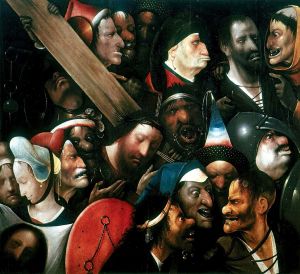 If we are not doing that we are then Crucifying Christ every day of our modern times. See polishing your Heart
If we are not doing that we are then Crucifying Christ every day of our modern times. See polishing your Heart
Christ Carrying the Cross (Bosch, Ghent)
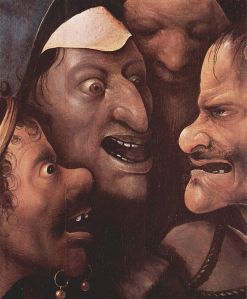 The work depicts Jesus carrying the cross above a dark background, surrounded by numerous heads, most of which are characterized with grotesque faces. There are a total of eighteen portraits, plus one on Veronica’s veil. Jesus has a woeful expression, his eyes are closed and the head is reclinating.
The work depicts Jesus carrying the cross above a dark background, surrounded by numerous heads, most of which are characterized with grotesque faces. There are a total of eighteen portraits, plus one on Veronica’s veil. Jesus has a woeful expression, his eyes are closed and the head is reclinating.
In the bottom right corner is the impenitent thief, who sneers against three men who are mocking him. The penitent thief is at top right: he is portrayed with very pale skin, while being confessed by a horribly ugly monk.
The bottom left corner shows Veronica with the holy shroud, with her eyes half-open and the face looking back. Finally, at the top left is Simon of Cyrene, his face upside upturned.
 While surrounded by the mob in caricature Christ is accompanied by Simon of Cyrene, St. Veronica and the Good and Bad Thieves. Veronica holds the imprinted face of Christ on her veil. The two faces of Jesus contrast sharply with the horrible faces around them. Bosch imbues the mob with faces of sin. Here humanity is ugly and full of evil. They externally bear the marks of their inner torment, as contrasted with the serene faces of Jesus and Veronica. José de Sigüenza, a 16th-century Spanish author, wrote: “The difference between the work of Bosch and that of other painters lies in the fact that the others depict man as he appears on the outside. Only Bosch dared to paint him the way he is on the inside.”
While surrounded by the mob in caricature Christ is accompanied by Simon of Cyrene, St. Veronica and the Good and Bad Thieves. Veronica holds the imprinted face of Christ on her veil. The two faces of Jesus contrast sharply with the horrible faces around them. Bosch imbues the mob with faces of sin. Here humanity is ugly and full of evil. They externally bear the marks of their inner torment, as contrasted with the serene faces of Jesus and Veronica. José de Sigüenza, a 16th-century Spanish author, wrote: “The difference between the work of Bosch and that of other painters lies in the fact that the others depict man as he appears on the outside. Only Bosch dared to paint him the way he is on the inside.”
This dramatic panel is “one of the most hallucinatory creations of the history of Western art”, in the words of Bosch expert Paul van den Broeck.
A reminder, most of the paintings by Bosch are religious, but at the same time, they ar e a critical analysis of the world and its human inhabitants. Bosch often does that in a highly ingenious way. This Christ Carrying the Cross demonstrates how deeply Bosch felt and identified with the suffering of Christ. This empathy fits in with the teachings of the late-medieval devotional movements from Bosch’s time, which saw Jesus as a lonely and resigned man who conquered the sins of the ugly and even bestial world all on his own. For Bosch Christ is the one to follow because He alone can forgive our ugliness (sin) and call us to a new beauty (grace.) . This is the message Bosch wanted to convey here.
e a critical analysis of the world and its human inhabitants. Bosch often does that in a highly ingenious way. This Christ Carrying the Cross demonstrates how deeply Bosch felt and identified with the suffering of Christ. This empathy fits in with the teachings of the late-medieval devotional movements from Bosch’s time, which saw Jesus as a lonely and resigned man who conquered the sins of the ugly and even bestial world all on his own. For Bosch Christ is the one to follow because He alone can forgive our ugliness (sin) and call us to a new beauty (grace.) . This is the message Bosch wanted to convey here.
 Bosch places the head of Christ at the crossing of two diagonal composition lines. One diagonal follows the beam of the Cross, from the head of Simon of Cyrene, the man who helped to carry Christ’s Cross, to the “bad thief” at the bottom right, who was crucified beside Christ. The second diagonal runs from the bottom left, with Veronica’s sudarium, to the pallid face of the “good thief” in the upper-right corner. He has the dubious pleasure of the company of a physician – or is it a Pharisee? – and a monk.
Bosch places the head of Christ at the crossing of two diagonal composition lines. One diagonal follows the beam of the Cross, from the head of Simon of Cyrene, the man who helped to carry Christ’s Cross, to the “bad thief” at the bottom right, who was crucified beside Christ. The second diagonal runs from the bottom left, with Veronica’s sudarium, to the pallid face of the “good thief” in the upper-right corner. He has the dubious pleasure of the company of a physician – or is it a Pharisee? – and a monk.
Drawing on our walk with Christ in the Ghent Christ Carrying the Cross, it may be good to paraphrase the ancient prayer to Santiago de Compostela:
Be for us our companion on our daily walks,
Our guide at the crossroads,
Our breath in our weariness,
Our protection in danger,
Our shelter on the way,
Our shade in the heat,
Our light in the darkness,
Our consolation in our discouragements,
And our strength in our intentions.
 The iconography of the Passion scenes which Bosch painted during his middle and later years are simpler than that of his earlier paintings, their imagery more easily grasped by the viewer. One such work is the Christ Carrying the Cross in the Palacio Real, Madrid. Christ dominates the foreground, almost crushed beneath the heavy Cross which the elderly Simon of Cyrene struggles to lift from his back. The ugly heads of his executioners rise steeply in a mass towards the left;
The iconography of the Passion scenes which Bosch painted during his middle and later years are simpler than that of his earlier paintings, their imagery more easily grasped by the viewer. One such work is the Christ Carrying the Cross in the Palacio Real, Madrid. Christ dominates the foreground, almost crushed beneath the heavy Cross which the elderly Simon of Cyrene struggles to lift from his back. The ugly heads of his executioners rise steeply in a mass towards the left;
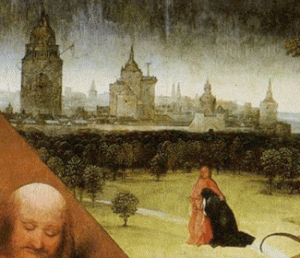 in the distance, the sorrowing Virgin collapses into the arms of John the Evangelist. Whereas Bosch’s earlier composition of this subject in Vienna had been diffuse and primarily narrative, the Madrid version is concentrated, and the way that Christ ignores his captors to look directly at the spectator gives it the quality of a timeless devotional image.
in the distance, the sorrowing Virgin collapses into the arms of John the Evangelist. Whereas Bosch’s earlier composition of this subject in Vienna had been diffuse and primarily narrative, the Madrid version is concentrated, and the way that Christ ignores his captors to look directly at the spectator gives it the quality of a timeless devotional image.
Walter S. Gibson in his work on Bosch states that some critics claim that Bosch equated the historical tormenters of Christ with humankind at large whose daily wickedness continues to torture Christ after his Resurrection. This concept of ‘Perpetual Passion’ was not uncommon in Bosch’s day. But is this what the face of Jesus is saying? Could it not be less an accusation and more an appeal to the viewer found within Matthew 16:24: ‘If any man will come after me, let him deny himself, and take up his cross, and follow me”?
Look here for A lifelong pilgrimage: The Mirrors of Jheronimus bosch

